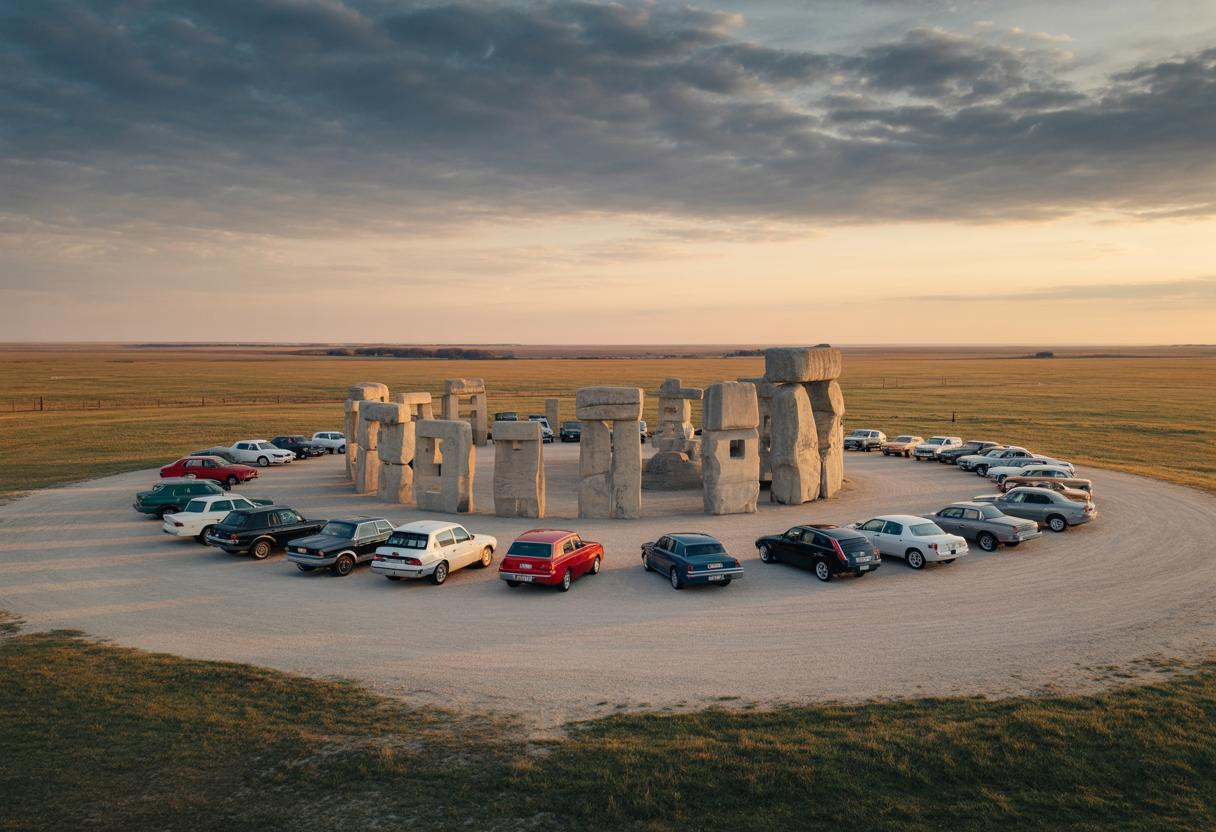In rural Nebraska, a monument built with 39 junk cars generates 100,000 visitors annually and demonstrates how individual vision combined with community stewardship can transform forgotten agricultural land into a thriving economic catalyst. Carhenge, located near Alliance, Nebraska, has become one of America’s most successful roadside attractions—proving that unconventional tourism models can sustain entire rural economies when executed with strategic planning and authentic storytelling.
This automotive tribute to England’s Stonehenge emerged from a deeply personal memorial project and evolved into a case study for rural development that offers valuable lessons for communities seeking economic diversification.
How a family memorial became an economic powerhouse
Jim Reinders created Carhenge in 1987 as a memorial to his father during a family reunion, arranging vintage automobiles in the exact proportions of the original Stonehenge. What started as private family art transformed into a regional economic driver when the community recognized its tourism potential.
The transition from private memorial to community asset required careful navigation. The Friends of Carhenge nonprofit managed the site from 1989 to 2013, mediating between preserving the memorial’s intent and maximizing public access. This model mirrors small rural communities that maintain unique governance structures while balancing private legacy with public benefit.
Free admission with voluntary donations creates a sustainable visitor experience that encourages repeat visits and positive word-of-mouth marketing—a strategy that generates consistent foot traffic without pricing out budget-conscious travelers.
The psychology behind its massive appeal
Cultural intersection drives emotional connection
Carhenge succeeds because it operates at the intersection of American car culture, agricultural heritage, and ancient mystique. Visitors experience cognitive delight when familiar objects (automobiles) are recontextualized in an unexpected historical framework (Neolithic monument).
The installation taps into America’s roadside art tradition while offering deeper cultural resonance than typical tourist traps. Unlike purely commercial attractions, Carhenge maintains authentic emotional weight through its memorial origins, creating lasting visitor satisfaction.
Strategic visibility maximizes discovery potential
Highway 87 placement ensures accidental discovery by thousands of travelers who weren’t specifically seeking the attraction. This organic exposure generates viral social media content as visitors share unexpected roadside encounters with their networks.
The flat Nebraska landscape provides unobstructed visibility from multiple angles, creating Instagram-worthy photo opportunities that function as free marketing across social platforms.
Economic impact extends beyond visitor numbers
Carhenge’s 80,000-100,000 annual visitors generate significant multiplier effects for local businesses including hotels, restaurants, and gas stations. This visitor volume rivals successful small-town tourism models that demonstrate how unique attractions can generate substantial economic returns.
The site requires minimal operational overhead—no admission collection, limited staffing needs, and low maintenance costs beyond periodic vehicle repainting. This high-margin tourism model maximizes community benefit while minimizing municipal resource strain.
Seasonal events like solstice celebrations and eclipse viewing leverage the site’s astronomical accuracy to create additional revenue opportunities through coordinated programming with local businesses.
Replication challenges reveal success factors
Attempts to replicate Carhenge’s success face significant barriers including zoning restrictions, community resistance, and lack of authentic cultural narrative. Successful roadside attractions require genuine emotional resonance rather than pure novelty.
Weather exposure threatens long-term preservation as Nebraska’s extreme temperatures stress automotive materials. Regular maintenance including rust prevention and structural reinforcement represents ongoing operational challenges that communities must address through dedicated funding mechanisms.
The site’s success depends heavily on grassroots community support rather than top-down municipal initiatives. This organic development pattern proves difficult to manufacture artificially in other locations.
Lessons for rural economic development
Carhenge demonstrates that rural communities can leverage unconventional assets when they embrace creative land use policies and support individual artistic vision. Like Nebraska’s unique municipal arrangements, successful rural attractions often emerge from flexible governance structures that accommodate non-traditional economic activities.
The hybrid public-private partnership model provides a replicable framework: individual creativity plus nonprofit stewardship plus municipal support creates sustainable tourism infrastructure without overwhelming any single stakeholder.
Communities seeking similar success should focus on authentic cultural narratives rather than manufactured attractions, ensuring long-term visitor satisfaction and positive community identity.
Why authentic weirdness beats manufactured tourism
Carhenge’s enduring appeal proves that genuine artistic expression combined with strategic community support creates more sustainable tourism than purely commercial ventures. Its success offers hope for rural communities willing to embrace unconventional economic development strategies while honoring local heritage and individual creativity.
